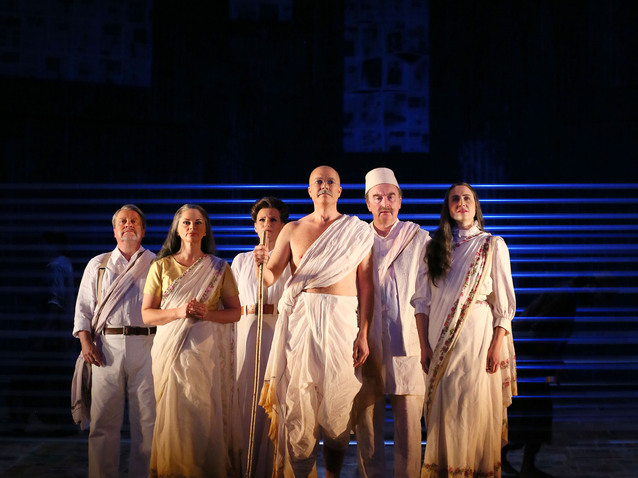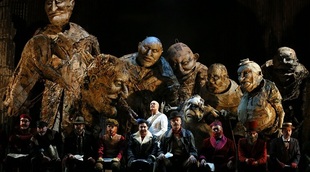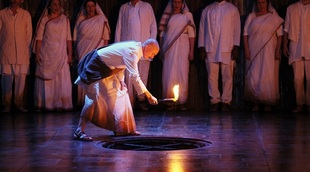 © DR
© DR
Philip Glass is recognised as one of the leading figures in minimalism today. He has written over twenty-five operas, and three of these form a trilogy that focus on pivotal figures in the fields of science, politics and religion respectively. Einstein on the Beach premiered in 1976 before the triptych was completed eight years later with Akhnaten.
In between these came Satyagraha in 1980, which explores the early active life of Mahatma Gandhi. It focuses on political struggle as it explores his associated movement for freedom and independence, and philosophy as it links its peaceful fight with centuries old religious teachings. The term Satyagraha itself roughly translates as ‘insistence on truth’ and describes nonviolent resistance, with subscribers to the approach becoming known as Satyagrahis.

Although there is some narrative progression to the piece, it is more meditative than plot driven as each of the seven scenes considers an event related in one way or another to India’s civil resistance movement. For example, the third focuses on a meeting in 1906 where everyone present swore an oath to resist the proposed Black Act, and their doing so is played out in more ways than one. We see the entire chorus raise their hands, but the act is also symbolised through such actions as everyone removing their jacket and placing it on a ‘coat hanger’ that then ascends. It is this large metaphorical element to the work that means that, while the opera is accessible, it is not necessarily self-explanatory. It is performed in Sanskrit, with translations of only some of the lines being projected, and this makes investing in a programme, which contains a detailed synopsis and full translation, advisable.
This is the third revival of Improbable director Phelim McDermott’s 2007 staging for English National Opera, and it is as slick and polished as ever. Against a semicircular backdrop of rusted corrugated iron, the visual rendering of the scenes is highly effective. There are brilliantly choreographed, and often ‘slow motion’, movements, and outstanding lighting designs from Paule Constable. The Improbable Skills Ensemble generates all sorts of effects as it seemingly conjures up puppets from discarded scraps. For example, the first scene describes the imminent battle between the Kuruvas and Pandavas. The warriors depicted are created out of newspaper and wicker baskets with the puppeteers lifting these into place to form heads, torsos and limbs so that giant figures ‘magically’ appear at the moment when everything fits into place. The final scene, which depicts The Newcastle March and related Coal Strike of 1913, sees numerous tapes spread right across the stage. These are then cut and bundled up to form a huge person where the skill in the original design is matched by the slickness in execution that ensures the same effect is achieved night after night.
The ruling classes in South Africa are also depicted with huge newspaper-faced puppets that are so engaging that one soon blocks out the person standing beneath the framework of each operating the limbs. At the end of the fifth scene the puppeteers whip up the scattered newspaper into a huge whirling mass. This then provides an excellent backdrop to the falling of registration cards from the ceiling that form the focus for the next scene. Other effects are more subtle. The second scene describes the establishing of Tolstoy Farm, a form of co-operative commonwealth, and is symbolised by introducing small two-dimensional houses to the stage. Then as the scene goes on, and the commune grows, these houses become bigger. Similarly, scene four sees people abuse Gandhi by throwing balls of newspaper at him, while the next focuses on Indian Opinion, a paper that he founded to help further the cause.
In this way, the production enchants and hypnotises the viewer just as much as Glass’s score. However, in the same way as the staging is multi-faceted, so too is the music. Glass actually dislikes the term minimalism because it misrepresents the amount going on in his works. Repetition is often a key component of them, and it should be noted that they do leave some people feeling cold, but there is much variation too. For example, scene four of Satyagraha writes the smug chuckles of the European men in South Africa laughing at Gandhi into the score.

The seven scenes are not always shown in the order in which the historical events occurred but we are still given a sense of progression from start to finish. This is because all three scenes in Act I see Gandhi dressed as he might have been when a law student in England, while scenes four to seven in Acts II and III see him in the traditional garments with which he is now associated. This is in spite of the fact that scene two, for example, represents an event that took place in 1910 and scene four an occurrence from 1896.
Although there are long periods when he remains silent on stage, the evening is dominated by the character of Gandhi who, after being played by Alan Oke for the original production and first two revivals, is now portrayed by Toby Spence. Spence, who has even shaved his head for the occasion, ensures that it is not only the ethereal quality in his warm tenor that shines through. Through his subtle expressions he really gives the impression of one who sees the whole world in all of its beauty and darkness. His face similarly reveals both the anxiety of an individual who knows they bear a huge responsibility and the serenity of one who believes in the total truth of what they do. With strong support from Charlotte Beament, Anna-Clare Monk, Stephanie Marshall, Nicholas Folwell and Clive Bayley in the other roles and exceptionally skilful conducting from Karen Kamensek, this is an excellent revival of an extremely significant and worthwhile work.
By Sam Smith
Satyagraha | 1 – 27 February 2018 | London Coliseum
the 11 of February, 2018 | Print
Comments